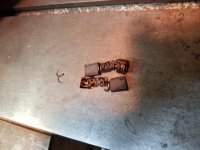BretSpegel
Plastic
- Joined
- Oct 7, 2019
Hi everyone, I have a Fadal 4020 built in 96 with DC servo motors that's having an issue where the Z axis will stop moving if I'm feeding it down at feedrates less than 10 IPM. It always seems to be at the same Z heights in different spots on the sxis, possibly in the same degree of revolution in the servo motor. When it happens the readout will show the z axis still moving but the axis will be physically stalled/not moving. The only way I can get it to resume moving is to press the E stop then manually grab the ball screw by hand & back it off a half a turn then reset the E stop. I can then bring it back to the cold start position, go through the cold start procedure & the Z axis will be calibrated to the same height it was before the issue so it's not like the resolver is slipping on the shaft. Does this sound like maybe an issue with brushes and/or maybe a dead spot in the motor? Any help or tips on where to look is very much appreciated!




